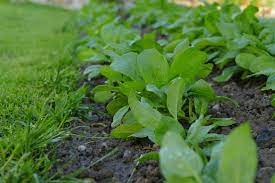Spinach is a warm-season leafy vegetable grown all over India; you can grow it commercially in the backyard as well as in open fields. It is Known for green leaves and vitamins; spinach is rich in iron and antioxidants. You can harvest spinach 6 to 8 weeks after planting. In warm climates, spinach produces seeds instead of growing leaves.
Some facts about Growing Spinach
- You can grow spinach in the sun to partial shade, and spinach is a cool-season crop that produces crops throughout the year. This crop can also be grown indoors.
- Spinach requires the best fertilisers and nutrients as it is a heavy nutrient. However, the (N-P-K) nitrogen, phosphorus, and potassium ratio should be good enough to grow healthy spinach leaves.
- Spinach usually germinates from seed and can even be grown from cuttings. You can keep 3 inches of space between plants and 2 feet from row to row.
- Spinach can grow back and produce many crops with proper growing methods.
- Farmers grow spinach as an annual crop and comes with some shade, and it requires 1 – 1.5 inches of water per week. In case of a dry and hot climate, it needs more water.
- Bolting of spinach occurs due to a lack of moisture (providing less water) in the late stage of the plant.
- This crop can be re-grown from cuttings, and spinach can be easily grown from seed germination.
Spinach Plantation – Climatic requirement
Spinach is a warm-season crop, but it can also be grown in the moderate winter season. It can tolerate frost therefore spinach thrives well in the winter season. It is susceptible to waterlogging and poor drainage. You can grow it successfully on plains and hills.
Spinach Plantation – Soil Requirement
Farmers grow spinach in any kind of well-drained soil; however, loamy soil is ideal for spinach farming. You should keep the soil loose so that spinach seedlings can establish roots quickly and easily. Add a fine layer of field yard manure or compost to the soil.
When you prepare the soil, you need the best equipment that will help in better and modern farming. You should use the latest tractor that is compatible with all attachments because the tractor is the most important factor for better farming.
Propagation and Sowing of Spinach
Spinach is propagated from seed, and farmers prepare soil that is enriched with FYM or compost and sows the seeds an inch deep and 1 inch apart. Water the soil without affecting the seeds and the seeds germinate in a week. Farmers sow it in this region as the main crop from October and as a summer crop in January-February. For this, 30-40 kg of seed requires per hectare. You soak the seeds in water before sowing, and seeds generally broadcast in flatbeds. However, line sowing at a distance of 20 cm is convenient for intercultural operation as it increases air circulation around the crop and reduces the chances of any fungal attack.
Fertilisers and Manures for Spinach
Spinach does not require feeding, and good quality compost works well as a fertiliser. There should be 30 to 50 cartloads of field yard compost (FYM) at the time of soil preparation. Applying 50 kg N/ha, a dose of N should be given at the time of sowing and also the remaining dose is again divided into two equal doses given at 1st and 2nd harvesting.
Spinach plants – Water Requirement
Mulch the soil using dry leaves, straw, etc., to retain moisture around the plant. The winter spinach crop requires irrigation at an interval of 10-15 days, depending on the soil type. The planted crop of spinach requires irrigation at an interval of 6 to 7 days during the summer to keep the soil moist.
Harvesting and the Yield of Spinach
Start harvesting the crop 6-8 weeks after planting. Cut off outer leaves that are 3-4 inches long. This will encourage more growth on the plant and ultimately result in more foliage for the crop. Only well-grown succulent and tender leaves are harvested. On average, the spinach crop gives 4 -6 cuttings. The total yield of green leaves is 80-100 quintals per hectare. After harvesting, the leaves are tied in bundles and sent for marketing. Remember to completely harvest the crop before the plant blots and produces seeds. (Generally, when the temperature rises, the increase in temperature causes the plant to flower and fruit and stop producing more leaves).
For better cultivation and productivity, you should do spinach farming in a modern way. The cultivation of spinach required better tractors and implements. And farmers can choose the better tractor according to their budget because you can find all tractor price online.
For further information regarding Spinach farming in India, stay tuned with us.

